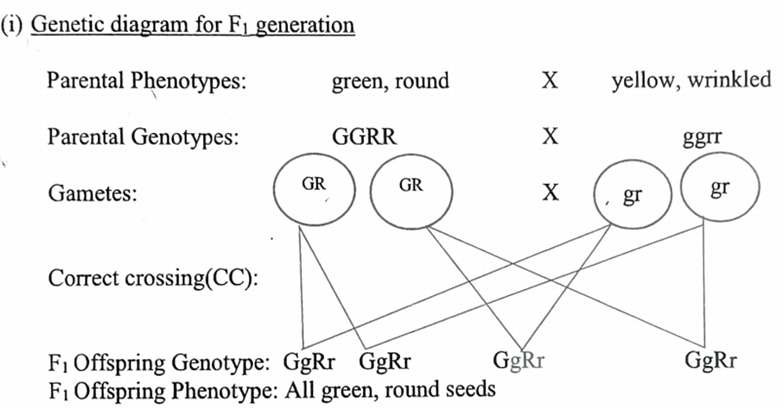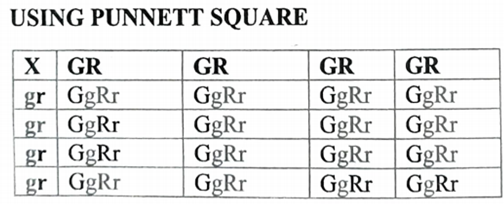2023 WASSCE BIOLOGY PAPER 2 QUESTIONS AND ANSWERS.

2023 WASSCE BIOLOGY PAPER 2 QUESTIONS AND ANSWERS.
1.
a. Explain briefly the following terms
i. Taxonomy
Taxonomy is a branch of biology, which involves a systemic classification of living things, into groups based on their similarities, forms, characteristics, genetics, and cellular organisation.
ii. Binomial nomenclature
Binomial nomenclature I the scientific method of naming organism, by giving them two names which are derived from their genus and species or specific epithet.
b. state two characteristics each of the members of the following classes of organisms.
i. Class Hepaticae characteristics
- Ripe capsule split into four halves to release spores.
- Capsule possesses oval/spherical shape
- the plant has leafy lobes thalloid.
- it is dorsoventrally flattened.
- thallus shows dichotomous branching
- they are non-vascular
- gametophyte is dominant.
ii. Class Musci characteristics
- gametophyte is differentiated into stems-like and leaf-like structures.
- their leaves do not possess stalk
- they are multicellular
- leaves are arranged spirally.
- rhizoids are septate.
- it produces haploid/dominant gametophyte.
c. Give one example each of members of the following organisms.
i. Class Hepaticae
- liverwort
- Marchantia
- Riccia
- Pellia
ii. Class Musci
- Moss
- Branchymenium
- Funaria
d. State four characteristics each of members of the following classes of organisms
i. Class Chilopoda characteristics
- they have segmented body
- bodies are elongated
- their bodies are flattened
- they are mostly active at night (the nocturnal)
- they possess a pair of simple eyes
- possess a pair of antennae
- also possess a pair of mandibles/maxillae
- possess a pair of legs on each abdominal segment
- they are terrestrial animals
- they are mostly predatory/carnivorous
- possess a pair of poisonous /venomous claws
- gaseous exchange is by trachea.
ii. Class Diplopoda characteristics
- they are terrestrial animals
- they are scavengers
- their body has pointed anterior end
- possess a pair of mandibles
- their body is cylindrical in shape
- possess a pair of antennae
- possess two pair of legs on each body segment
- bodies are divided into head, thorax and abdomen.
e. Give one example each of the following classes of organisms.
i. Class Chilopoda
- Centipede
ii. Class Diplopoda
- Millipede
99 BIOLOGY OBJECTIVE QUESTIONS ON CONTROL AND COORDINATION WITH ANSWERS.
Multiple Choice Questions on Humans Ecology and Health with Answers
Biological Practical section Five (5). On Tadpole
2.
a. State four adaptation of the small intestine in humans to its function.
- the inner walls have many folds, for maximum absorption of substances.
- have increased or large surface area for maximum absorption of substances
- are long to increase time for maximum absorption.
- have finger-like projections/villi which facilitate diffusion/absorption of food and also for easy/fast diffusion.
- are richly supply with blood vessels/ capillaries for quick transport of digested food into the blood stream.
b. Name three elements that are supplied to plants through the application of fertilizer.
- Nitrogen
- Phosphorus
- Potassium
c. State three ways by which water is important to plants.
- Medium for translocation of food.
- Raw material for photosynthesis
- Needed to maintain cell turgidity
- Medium for enzymatic/metabolic activities
- Medium for transport of gametes in lower plants
- transpiration of water allows cooling effect on plants.
d. explain briefly the reason why a high concentration of salts in the soil tend to reduce transpiration.
- the cell sap of root hairs is more dilute than the soil water
- causing water to move out of the cell sap into the soil
- less water will reach the leaves
- hence the reduction in transpiration
- exposure to high concentration of salt adversely affects growth of plants
- by wilting.
e. Name three proteases secreted by the stomach and the pancreas.
- Pepsin
- Rennin
- Trypsin
- Chymotrypsin
- Carboxypeptidase
3.
a. Explain briefly the reason why bread becomes mouldy when left at room temperature for days.
- mould spores are borne in the air
- bread provides suitable substrate for mould spores
- spores land on the bread and begins to grow or multiply
- under optimum temperature or pressure.
b. State three ways by which bread could be prevented from developing mold.
- keeping the bread in a dry place
- keep the bread in tightly sealed polythene bag
- store bread in freezer/fridge.
c. explain briefly the following terms
i. microbe
This is a minute or unicellular organism that is invisible to the naked eyes and could only be seen under the microscope.
ii. disease
This is an abnormal condition/disorder/illness which adversely affects the structure/function of part/all of a living organism.
iii. toxin
This is a harmful or poisonous substance of plants/animals/microorganism which acts as an antigen in the body of other organism stimulating the production of antibody.
iv. metabolic waste
This is a substance produced from chemical processes or cellular activities in a living cell which can not be used by the organism therefore, it must be excreted.
d. State three ways by which caterpillar is adapted to its habitat.
- has well developed mandibles for chewing
- possess claspers for gripping/holding onto support
- presence of proleg and claspers for climbing or walking holding onto stems or leaves
- colour of skin for camouflage
- possess spiracle for gaseous exchange
- also, presence of bristle for defence.
- osmeterium emits foul smell to scare predators or as a defence mechanism.
4.
a. A homozygous pea plant with green and round seeds (GR) was crossed with a recessive pea plant that produce yellow and wrinkle seeds.
i. With the aid of genetic diagram, state the genotype and phenotype of the F1 generation.

OR

ii. The F1 generation was self pollinated. With the aid of genetic diagram, state the genotype of the F2 generation.

b. List two examples of social insects.
- Termites
- Ants
- Honeybee or bee
- Wasp
5.
a. Explain briefly the following statements
i. Food chains are usually limited to three or four trophic levels
- Food chain consist of producers, herbivores and carnivores
- the ultimate source of energy is the sun
- the initial source of energy is obtained from the sun by the producers (green plants to manufacture food) which is the first level of organisation
- is transferred to the herbivores /secondary level organism/primary consumer in a much-reduced amount.
- and similarly, to the smaller carnivores/third level organism
- and to the higher carnivores/fourth level organisms or tertiary consumers.
- therefore, the longer the food chain the greater the energy loss or the smaller the amount of energy available.
ii. Eukaryotic cells are generally larger than prokaryotic cells.
Eukaryotic cells possess more organelles which are membrane bound and the presence of membrane add to the size of the cell.
b. Describe the roles which the following processes play in maintaining constant body temperature in mammals.
i. Vasodilation
- in hot weather,
- the body tends to gain heat from the environment
- the hypothalamus stimulates blood capillaries near the skin surface dilate
- while the capillaries in the deeper layers of the skin contract
- this causes a large volume of blood to flow near the surface of the skin
- so that heat is lost from the skin to the surrounding through radiation/convention/conduction.
ii. Vasoconstriction.
- in cold weather,
- the body tend to lose heat to the environment
- the hypothalamus causes blood capillaries near the skin narrow/constrict in diameter
- this reduces the volume of blood flowing to the skin
- thereby reducing heat loss from the skin to the surrounding environment
c. Name three elements that are common to the chemical composition of carbohydrates and lipids.
- carbon
- hydrogen
- oxygen
d. State two differences between the chemical composition of carbohydrates and lipids.
|
Carbohydrates |
Lipids |
| Ratio of hydrogen to oxygen is 2:1. | Ratio of hydrogen to oxygen is less than 2:1. |
| Phosphorus or nitrogen or sulphur is absent. | Some lipids contain Phosphorus or nitrogen or sulphur. |
e. Explain briefly how constipation result in dry-hard stool.
- lack of fibre in diet
- undigested food stays too long in the large intestine or colon
- large amount of water is absorbed by the colon or large intestine.
f. complete the table below by defining the following processes in digestion and mention the part of the digestive system where each of the processes occurs in humans.
|
Process |
Defining the process |
One part of the digestive system where process occur. |
| Ingestion | Intake of food into the mouth | Mouth/ buccal cavity |
| Absorption | Movement of digested food/end products of digestion from the small intestine into the blood. | Ileum or small intestine |
| Egestion | Removal of undigested food or faeces through the anus. | Anus. |





